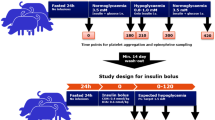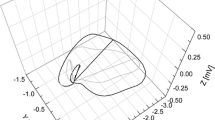Abstract
Patients with perturbed metabolic control are more prone to develop cardiac rhythm disturbances. The main purpose of the present preclinical study was to investigate the possible role of euglycemic hyperinsulinemia in development of cardiac arrhythmias. Euglycemic hyperinsulinemia was induced in conscious rabbits equipped with a right ventricular pacemaker electrode catheter by hyperinsulinemic euglycemic glucose clamp (HEGC) applying two different rates of insulin infusion (5 and 10 mIU/kg/min) and variable rate of glucose infusion to maintain euglycemia (5.5 ± 0.5 mmol/l). The effect of hyperinsulinemia on cardiac electrophysiological parameters was continuously monitored by means of 12-lead surface ECG recording. Arrhythmia incidence was determined by means of programmed electrical stimulation (PES). The possible role of adrenergic activation was investigated by determination of plasma catecholamine levels and intravenous administration of a beta adrenergic blocking agent, metoprolol. All of the measurements were performed during the steady-state period of HEGC and subsequent to metoprolol administration. Both 5 and 10 mIU/kg/min insulin infusion prolonged significantly QTend, QTc, and Tpeak–Tend intervals. The incidence of ventricular arrhythmias generated by PES was increased significantly by euglycemic hyperinsulinemia and exhibited linear relationship to plasma levels of insulin. No alteration on plasma catecholamine levels could be observed; however, metoprolol treatment restored the prolonged QTend, QTc, and Tpeak–Tend intervals and significantly reduced the hyperinsulinemia-induced increase of arrhythmia incidence. Euglycemic hyperinsulinemia can exert proarrhythmic effect presumably due to the enhancement of transmural dispersion of repolarization. Metoprolol treatment may be of benefit in hyperinsulinemia associated with increased incidence of cardiac arrhythmias.




Similar content being viewed by others
References
Adabag AS, Peterson G, Apple FS, Titus J, King R, Luepker RV (2010) Etiology of sudden death in the community: results of anatomical, metabolic, and genetic evaluation. Am Heart J 159(1):33–39. doi:10.1016/j.ahj.2009.10.019
Antzelevitch C (2007) Heterogeneity and cardiac arrhythmias: an overview. Hear Rhythm 4(7):964–972
Antzelevitch C, Oliva A (2006) Amplification of spatial dispersion of repolarization underlies sudden cardiac death associated with catecholaminergic polymorphic VT, long QT, short QT and Brugada syndromes. J Intern Med 259(1):48–58. doi:10.1111/j.1365-2796.2005.01587.x
Antzelevitch C, Shimizu W, Yan GX, Sicouri S, Weissenburger J, Nesterenko VV, Burashnikov A, Di DJ, Saffitz J, Thomas GP (1999) The M cell: its contribution to the ECG and to normal and abnormal electrical function of the heart. J Cardiovasc Electrophysiol 10(8):1124–1152
Antzelevitch C, Sicouri S, Di Diego JM, Burashnikov A, Viskin S, Shimizu W, Yan GX, Kowey P, Zhang L (2007) Does Tpeak-Tend provide an index of transmural dispersion of repolarization? Hear Rhythm 4(8):1114–1116. doi:10.1016/j.hrthm.2007.05.028
Antzelevitch C, Sicouri S, Litovsky SH, Lukas A, Krishnan SC, Di Diego JM, Gintant GA, Liu DW (1991) Heterogeneity within the ventricular wall. Electrophysiology and pharmacology of epicardial, endocardial, and M cells. Circ Res 69(6):1427–1449
Bazett HC (1920) An analysis of the time-relation of electrocardiogram. Heart 7:353–370
Bril A, Gout B, Bonhomme M, Landais L, Faivre JF, Linee P, Poyser RH, Ruffolo RR Jr (1996) Combined potassium and calcium channel blocking activities as a basis for antiarrhythmic efficacy with low proarrhythmic risk: experimental profile of BRL-32872. J Pharmacol Exp Ther 276(2):637–646
Brown DW, Giles WH, Greenlund KJ, Valdez R, Croft JB (2001) Impaired fasting glucose, diabetes mellitus, and cardiovascular disease risk factors are associated with prolonged QTc duration. Results from the third national health and nutrition examination survey. J Cardiovasc Risk 8(4):227–233
Cheng J, Kamiya K, Liu W, Tsuji Y, Toyama J, Kodama I (1999) Heterogeneous distribution of the two components of delayed rectifier K + current: a potential mechanism of the proarrhythmic effects of methanesulfonanilideclass III agents. Cardiovasc Res 43(1):135–147
Drimba L, Hegedus C, Yin D, Sari R, Nemeth J, Szilvassy Z, Peitl B (2012) Beneficial cardiac effects of cicletanine in conscious rabbits with metabolic syndrome. J Cardiovasc Pharmacol 60(2):208–218
Goldman SA (1940) The electrocardiogram in insulin shock. Arch Intern Med 66:93–108
Havel PJ, Taborsky GJ Jr (1989) The contribution of the autonomic nervous system to changes of glucagon and insulin secretion during hypoglycemic stress. Endocr Rev 10(3):332–350
Killeen MJ, Sabir IN, Grace AA, Huang CL (2008) Dispersions of repolarization and ventricular arrhythmogenesis: lessons from animal models. Prog Biophys Mol Biol 98(2-3):219–229. doi:10.1016/j.pbiomolbio.2008.10.008
Laitinen T, Vauhkonen I, Niskanen L, Hartikainen J, Uusitupa M, Laakso M (2003) Prolonged corrected QT interval is associated with acute and chronic hyperinsulinemia in nondiabetic subjects. Diabetes Care 26(8):2480–2481
Landstedt-Hallin L, Englund A, Adamson U, Lins PE (1999) Increased QT dispersion during hypoglycaemia in patients with type 2 diabetes mellitus. J Intern Med 246(3):299–307
Laurita KR, Girouard SD, Akar FG, Rosenbaum DS (1998) Modulated dispersion explains changes in arrhythmia vulnerability during premature stimulation of the heart. Circulation 98(24):2774–2780
Laurita KR, Girouard SD, Rosenbaum DS (1996) Modulation of ventricular repolarization by a premature stimulus. Role of epicardial dispersion of repolarization kinetics demonstrated by optical mapping of the intact guinea pig heart. Circ Res 79(3):493–503
Maier S, Aulbach F, Simm A, Lange V, Langenfeld H, Behre H, Kersting U, Walter U, Kirstein M (1999) Stimulation of L-type Ca2+ current in human atrial myocytes by insulin. Cardiovasc Res 44(2):390–397
Movahed MR, Hashemzadeh M, Jamal M (2007) Increased prevalence of ventricular fibrillation in patients with type 2 diabetes mellitus. Hear Vessel 22(4):251–253
Opthof T, Coronel R, Wilms-Schopman FJ, Plotnikov AN, Shlapakova IN, Danilo P Jr, Rosen MR, Janse MJ (2007) Dispersion of repolarization in canine ventricle and the electrocardiographic T wave: Tp-e interval does not reflect transmural dispersion. Heart rhythm Off J Heart Rhythm Soc 4(3):341–348. doi:10.1016/j.hrthm.2006.11.022
Peitl B, Nemeth J, Pankucsi C, Szilvassy Z (2006) Insulin sensitization induced by oral cicletanine in conscious rabbits. Naunyn Schmiedebergs Arch Pharmacol 373(6):429–439
Reaven GM (2003) Insulin resistance/compensatory hyperinsulinemia, essential hypertension, and cardiovascular disease. J Clin Endocrinol Metab 88(6):2399–2403
Robinson RT, Harris ND, Ireland RH, Lee S, Newman C, Heller SR (2003) Mechanisms of abnormal cardiac repolarization during insulin-induced hypoglycemia. Diabetes 52(6):1469–1474
Roden DM, Yang T (2005) Protecting the heart against arrhythmias: potassium current physiology and repolarization reserve. Circulation 112(10):1376–1378. doi:10.1161/CIRCULATIONAHA.105.562777
Said TH, Wilson LD, Jeyaraj D, Fossa AA, Rosenbaum DS (2012) Transmural dispersion of repolarization as a preclinical marker of drug-induced proarrhythmia. J Cardiovasc Pharmacol 60(2):165–171. doi:10.1097/FJC.0b013e3182597f67
Shimizu W, Antzelevitch C (1999) Differential response of transmural dispersion of repolarization and torsade de pointes to beta-adrenergic agonists and antagonists in three models of the long QT syndrome. J Electrocardiol 32 Suppl:150
Shimizu W, Antzelevitch C (2000) Differential effects of beta-adrenergic agonists and antagonists in LQT1, LQT2 and LQT3 models of the long QT syndrome. J Am Coll Cardiol 35(3):778–786
Shimizu W, Tanabe Y, Aiba T, Inagaki M, Kurita T, Suyama K, Nagaya N, Taguchi A, Aihara N, Sunagawa K, Nakamura K, Ohe T, Towbin JA, Priori SG, Kamakura S (2002) Differential effects of beta-blockade on dispersion of repolarization in the absence and presence of sympathetic stimulation between the LQT1 and LQT2 forms of congenital long QT syndrome. J Am Coll Cardiol 39(12):1984–1991
Start RD, Barber C, Kaschula RO, Robinson RT (2007) The ‘dead in bed syndrome’—a cause of sudden death in type 1 diabetes mellitus. Histopathology 51(6):843–845. doi:10.1111/j.1365-2559.2007.02829.x
Szilvassy Z, Csont T, Pali T, Droy-Lefaix MT, Ferdinandy P (2001) Nitric oxide, peroxynitrite and cGMP in atherosclerosis-induced hypertension in rabbits: beneficial effects of cicletanine. J Vasc Res 38(1):39–46
Szilvassy Z, Ferdinandy P, Bor P, Jakab I, Lonovics J, Koltai M (1994) Ventricular overdrive pacing-induced anti-ischemic effect: a conscious rabbit model of preconditioning. Am J Physiol 266(5 Pt 2):H2033–H2041
Szilvassy Z, Ferdinandy P, Szilvassy J, Nagy I, Karcsu S, Lonovics J, Dux L, Koltai M (1995) The loss of pacing-induced preconditioning in atherosclerotic rabbits: role of hypercholesterolaemia. J Mol Cell Cardiol 27(12):2559–2569
Walker MJ, Curtis MJ, Hearse DJ, Campbell RW, Janse MJ, Yellon DM, Cobbe SM, Coker SJ, Harness JB, Harron DW (1988) The Lambeth Conventions: guidelines for the study of arrhythmias in ischaemia infarction, and reperfusion. Cardiovasc Res 22(7):447–455
Yan GX, Antzelevitch C (1998) Cellular basis for the normal T wave and the electrocardiographic manifestations of the long-QT syndrome. Circulation 98(18):1928–1936
Zhang Y, Xiao J, Wang H, Luo X, Wang J, Villeneuve LR, Zhang H, Bai Y, Yang B, Wang Z (2006) Restoring depressed HERG K+ channel function as a mechanism for insulin treatment of abnormal QT prolongation and associated arrhythmias in diabetic rabbits. Am J Physiol Heart Circ Physiol 291(3):H1446–H1455. doi:10.1152/ajpheart.01356.2005
Zhang YH, Hancox JC (2003) A novel, voltage-dependent nonselective cation current activated by insulin in guinea pig isolated ventricular myocytes. Circ Res 92(7):765–768. doi:10.1161/01.RES.0000065920.64121.FC
Acknowledgments
This study was supported by the Hungarian National Office for Research and Technology (NKFP_07-A2-2008-0260, GOP-1.1.2-07/1-2008-0004, TÁMOP-4.2.2.-08/1-2008-0014, OM-00174/2008, TÁMOP-4.2.2/B-10/1-2010-0024, GOP-1.1.1-07/1-2008-0032, and GOP-1.2.1-08-2009-0023) and the Hungarian Scientific Research Fund (OTKA-75965).
Author information
Authors and Affiliations
Corresponding author
Rights and permissions
About this article
Cite this article
Drimba, L., Döbrönte, R., Hegedüs, C. et al. The role of acute hyperinsulinemia in the development of cardiac arrhythmias. Naunyn-Schmiedeberg's Arch Pharmacol 386, 435–444 (2013). https://doi.org/10.1007/s00210-013-0845-4
Received:
Accepted:
Published:
Issue Date:
DOI: https://doi.org/10.1007/s00210-013-0845-4




